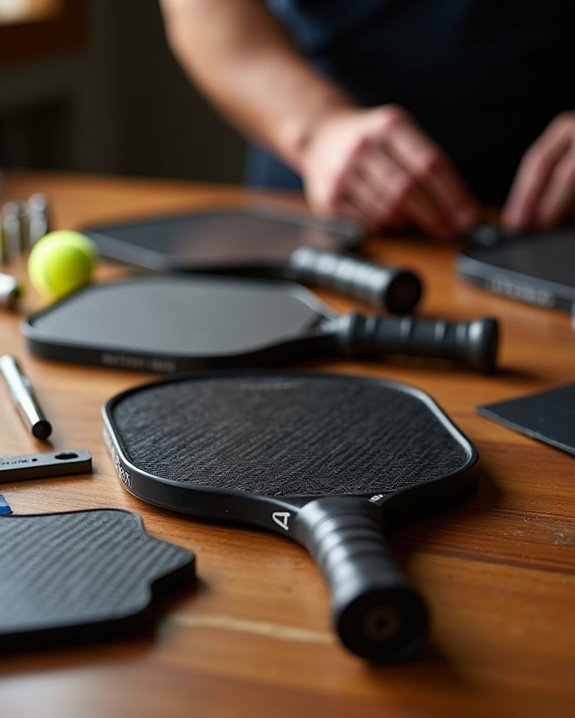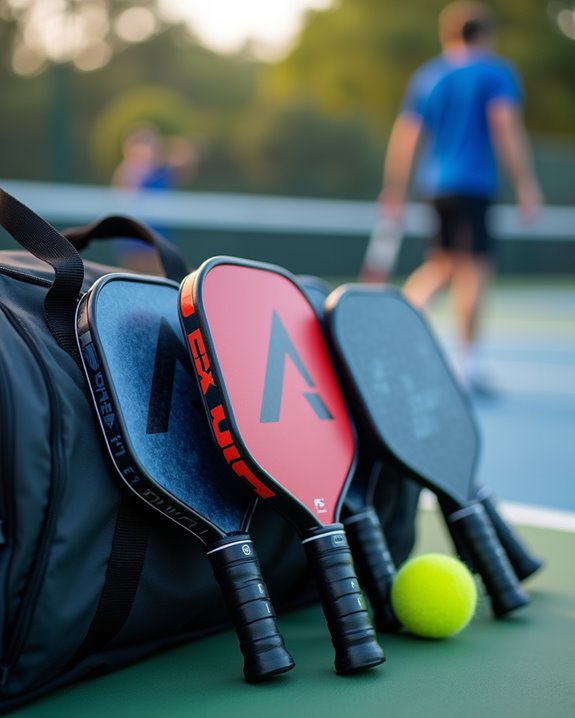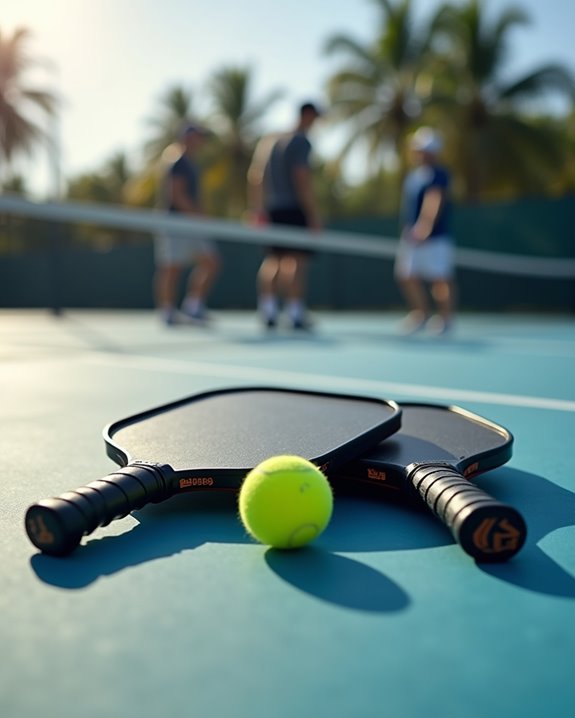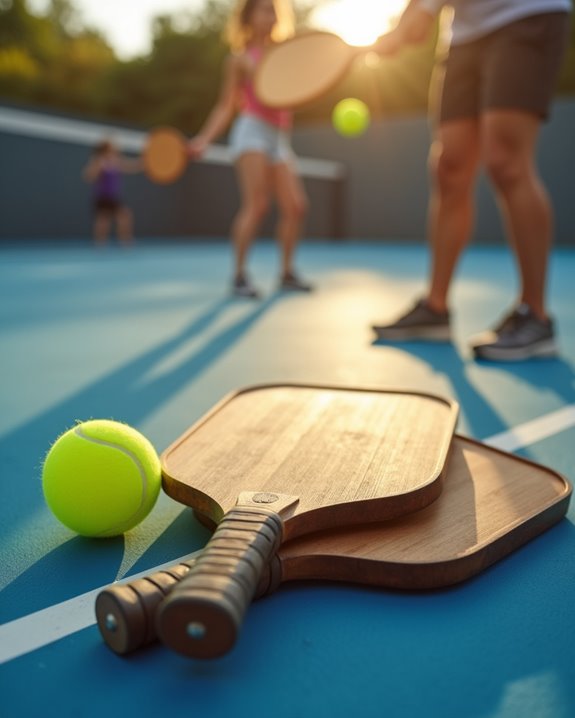Pickleball paddles carry hefty price tags because they’re crafted with premium materials like carbon fiber and specialized polymers that undergo at least 30 distinct manufacturing processes. You’re paying for years of R&D investment, precision engineering, and rigorous quality control testing. Each paddle is fundamentally a recipe of advanced technology—from vibration dampening systems to aerodynamic designs. Brand reputation and professional endorsements also flavor the final cost. Discover what makes your perfect paddle worth the investment below.
Key Takeaways
- High-quality materials like carbon fiber and advanced composites significantly increase manufacturing costs.
- Extensive research, development, and certification processes (including USAPA fees up to $1,950) impact pricing.
- Sophisticated production techniques require at least 30 distinct manufacturing processes for each paddle.
- Brand reputation, professional player endorsements, and marketing strategies contribute to premium pricing.
- Customization options and performance-enhancing features like vibration dampening systems justify higher costs.
Premium Materials Driving Up Costs
While you’re shopping for your next pickleball paddle, you’ll quickly notice that prices can range dramatically based on materials alone. Just like selecting prime ingredients for a gourmet dish, premium materials greatly impact the cost of paddles.
Carbon fiber—the filet mignon of paddle construction—delivers the perfect blend of lightweight feel and crisp response, but at a higher price point. High-quality paddles using advanced materials like T700 carbon fiber command prices starting at $80 because they’re engineered to enhance your game’s flavor. T700 carbon fiber paddles offer a combination of strength and performance that justifies their premium pricing.
Composite paddles offer a more affordable middle ground ($50-$100), similar to choosing a quality olive oil instead of truffle oil. The sophisticated manufacturing process behind graphite paddles requires extensive research to perfect the recipe, ensuring you get durability and performance worth savoring.
Research and Development Investments
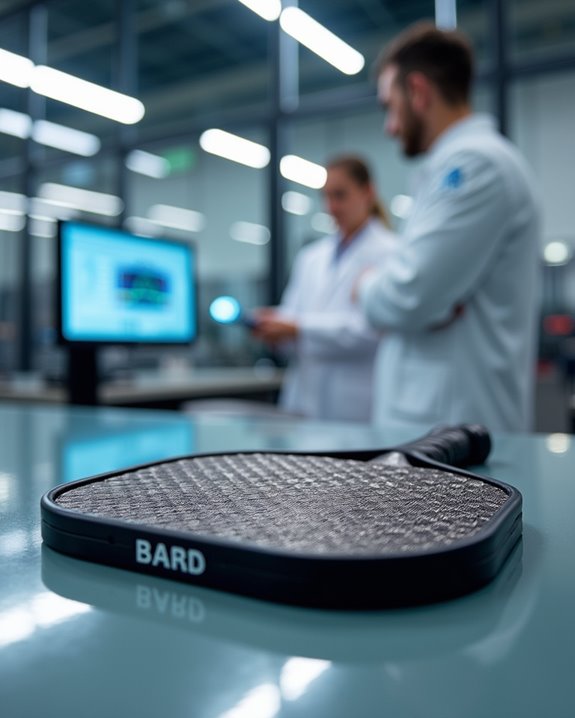
Behind every paddle that delivers that satisfying “pop” when you connect with the ball lies years of intensive research and development. Manufacturers are constantly simmering up innovative paddle designs that require substantial resources for material testing.
You’re paying for the countless hours spent perfecting that T700 carbon fiber blend, just as a chef might experiment with ingredients to create the perfect sauce. These R&D investments directly impact production costs when companies develop advanced manufacturing processes like thermoforming and hot press casting—techniques that enhance paddle performance while driving up prices.
Additionally, certification processes for high-quality paddles add another layer to the expense. When you grip your paddle, you’re holding the culmination of extensive scientific exploration—a recipe refined through trial and error to deliver that perfect blend of power and control. The use of advanced materials and technology in paddle construction further emphasizes the importance of these investments in achieving optimal performance.
Manufacturing Complexity and Precision
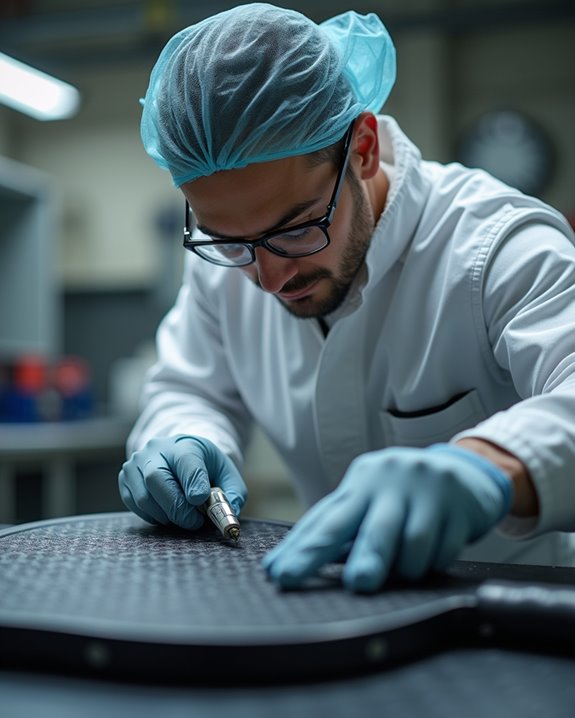
Unlike basic kitchen tools that require simple production, today’s pickleball paddles demand a recipe of at least 30 distinct manufacturing processes from start to finish. You’re paying for the meticulous blend of advanced materials like carbon fiber mesh that must be precisely layered, similar to creating a perfect mille-feuille pastry.
Gen 3 paddles are particularly complex to “cook up,” requiring specialized techniques like thermoforming and hot press casting. The production costs soar due to stringent quality control measures—even a 1mm variation can ruin the paddle’s performance! Research and Development investments continually refine these paddle technologies, while certification requirements add another layer of expense. Before reaching your hands, each paddle undergoes rigorous testing and compliance procedures, ensuring it meets the exact recipe specifications established by professional leagues.
Brand Reputation and Endorsements
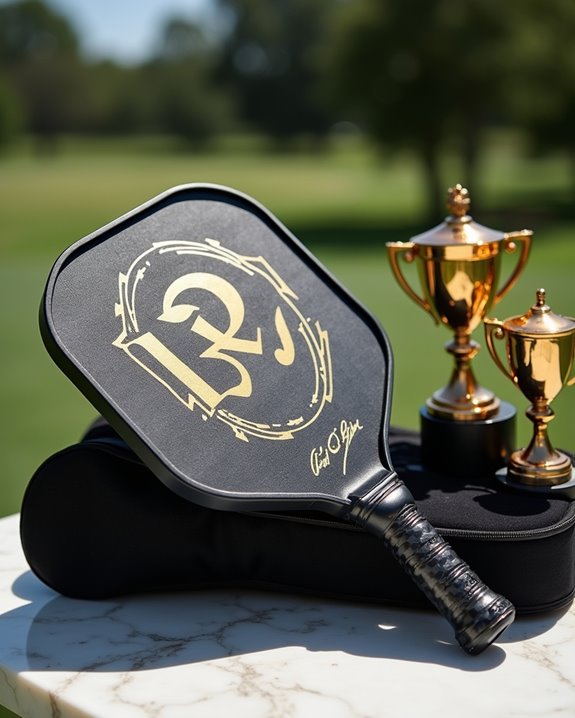
As you browse the pickleball paddle market, brand reputation simmers beneath the surface of every price tag you’ll encounter. Established premium brands like Selkirk and Joola have carefully marinated their status in the industry, allowing them to command higher prices based on perceived value rather than material costs alone.
When Joola serves up an endorsement deal with a top player like Ben Johns, they’re fundamentally adding a gourmet garnish that justifies price increases. You’re not just buying graphite and polymer—you’re investing in the secret sauce of brand loyalty.
Their marketing strategies have perfected the recipe for consumer behavior: create desire through association with excellence. You might find yourself willing to pay extra for that paddle with the recognizable logo, believing it will help you dish out better performance on the court. This perception is further reinforced by the paddle’s USAPA-approved status, ensuring that players are not only buying quality but also compliance for tournament play.
Supply Chain and Production Scale
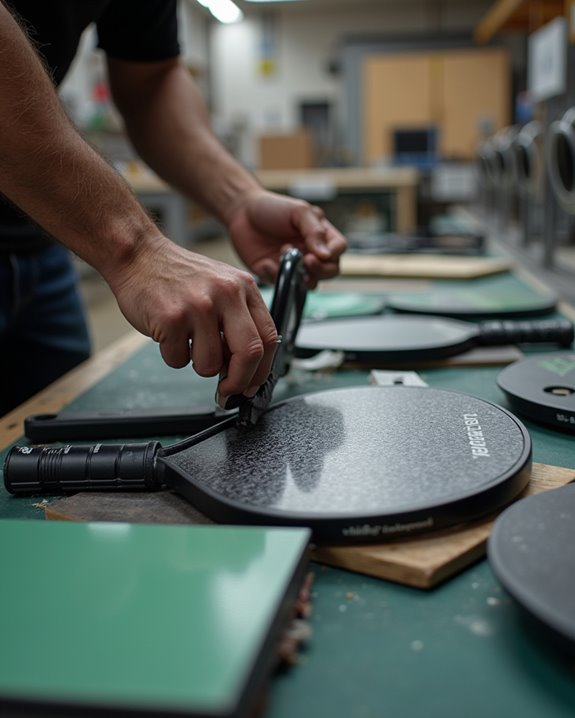
Beyond the glossy endorsements and brand prestige, your paddle’s price tag is deeply rooted in the complex recipe of manufacturing economics.
When you’re gripping that high-performance paddle, you’re holding the result of significant capital investment in specialized equipment and manufacturing processes. Production scale matters enormously—small-batch paddles cost more to “cook up” than mass-produced versions, just like artisanal bread versus factory loaves. The supply chain for high-quality polymers and advanced materials can simmer with price volatility, while skilled labor costs and stringent quality control guarantee your paddle performs consistently with every serve. Don’t forget the overhead expenses baked into each unit—electricity, insurance, and facility maintenance all season the final price. These behind-the-scenes ingredients explain why that premium paddle commands a premium price.
Technology and Performance Innovations
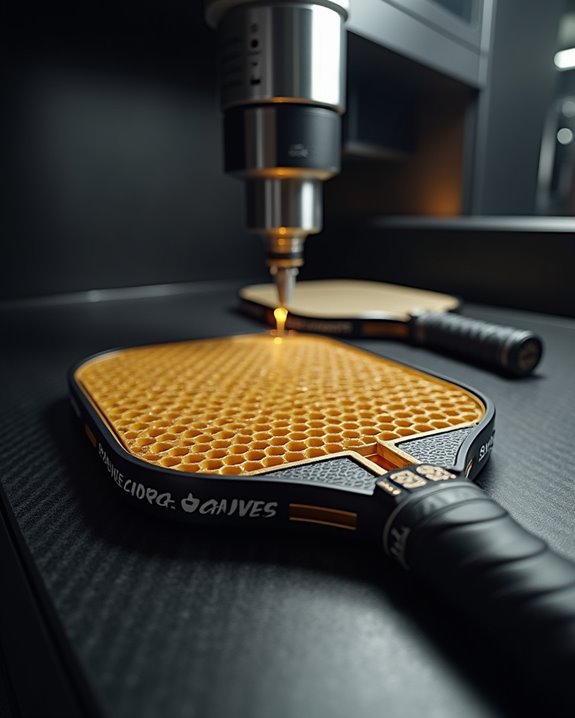
While you’re admiring your paddle’s sleek design, it’s worth exploring the high-tech ingredients that create its hefty price tag. Advanced manufacturing techniques like thermoforming and hot press casting are folded into paddle production, just as a chef incorporates premium ingredients into a gourmet dish.
Research and development investments are the secret sauce behind innovations like T700 carbon fiber and vibration dampening systems. These performance enhancements don’t come cheap! Materials science has transformed paddles with polymer cores and PMI foam that serve up the perfect blend of power and control.
Aerodynamics optimization is another vital element in the recipe. Engineers meticulously test designs to guarantee your paddle slices through air with minimal resistance. Don’t forget certification fees—these confirm your paddle is properly seasoned to meet USAPA standards for competitive play.
Durability and Longevity Factors
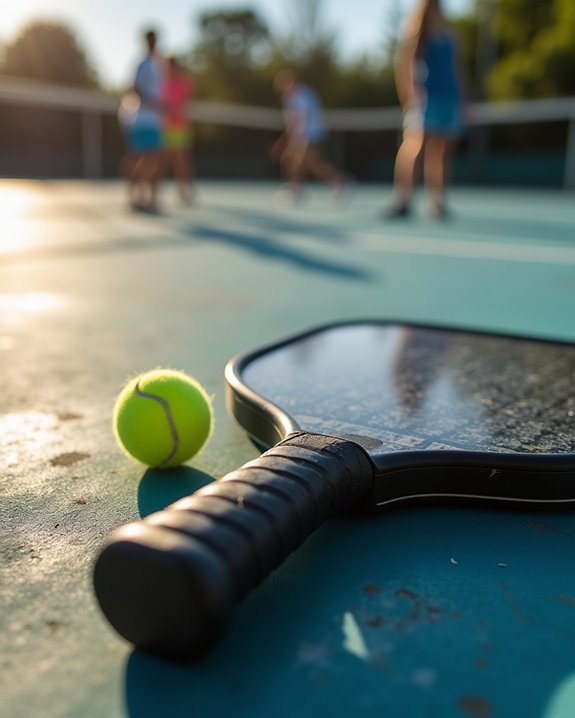
When you’ve invested in a pickleball paddle, its staying power becomes just as essential as its performance on the court. High-quality materials like carbon fiber and composite blends are the prime ingredients in a recipe for durability, ensuring your paddle can withstand the heat of competitive play.
The manufacturing process of premium paddles involves rigorous quality control—much like a chef testing each dish before service. This meticulous attention maintains structural integrity over time. You’ll appreciate how paddles with vibration dampening and edge guards protect against daily wear, preserving their crisp response and sweet spot.
While the upfront cost may seem steep, consider it a long-term investment. A well-crafted paddle will deliver a consistent gameplay experience for years, making that initial price sizzle worth every penny.
Competitive Market Pricing Strategies
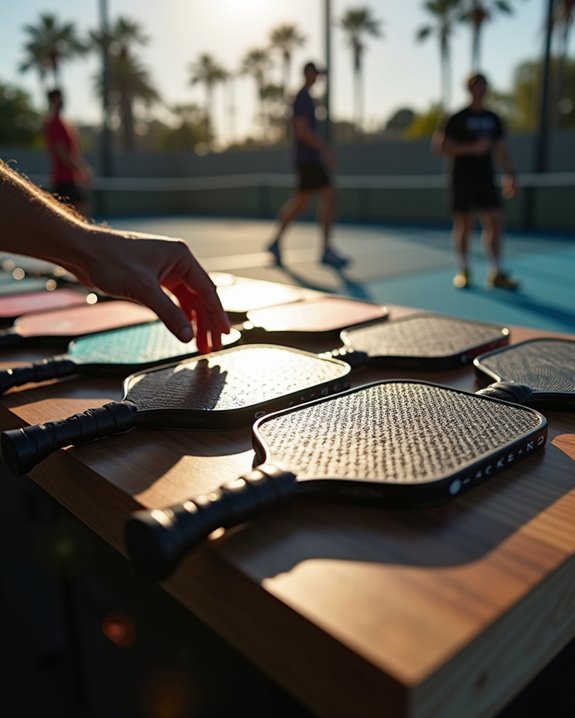
The sizzling world of pickleball paddle pricing isn’t just about materials and construction—it’s a complex recipe of brand positioning, player endorsements, and market psychology.
When you’re shopping for that perfect paddle, you’re tasting the results of intense competitive market dynamics. Major brands fold premium pricing into their strategy like a master chef, blending advanced manufacturing techniques with innovative materials to create performance features that serious players crave.
You’ll notice how companies constantly stir their research and development pots, adding ingredients like certification standards compliance to justify higher costs. This market dynamic allows manufacturers to serve up paddles at various price points, with top-shelf options garnished with professional endorsements. The result? A menu where you’re paying not just for the paddle, but for the brand’s reputation and perceived performance benefits.
Design Elements and Customization Options
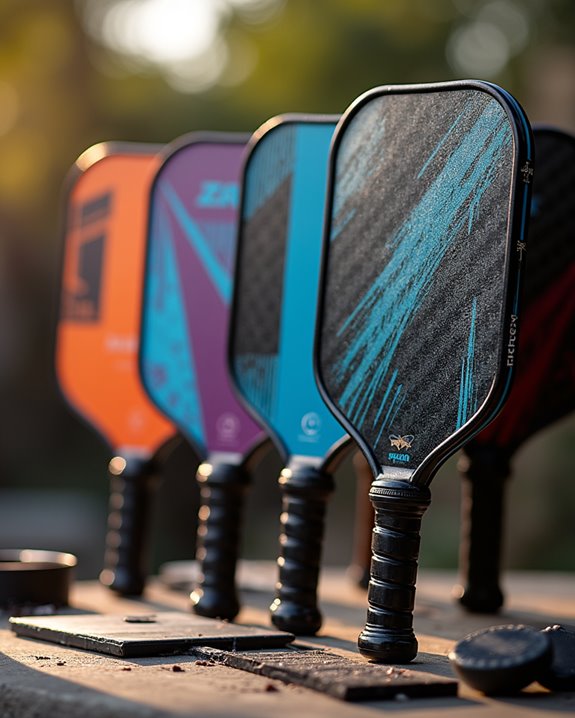
Diving into pickleball paddle design feels like exploring a gourmet menu where each feature adds distinct flavor to your game. You’ll find wider paddles offer a generous sweet spot—like a perfectly seared steak—while narrower options deliver precision control, similar to a delicate sauce reduction.
When you’re shopping for paddles, you’re paying for the extensive R&D that goes into creating these performance-enhancing tools. Advanced design features like vibration dampening act as flavor enhancers, reducing fatigue during extended play sessions. Ergonomic grips, customized to your hand size, guarantee the perfect “bite” on every swing.
The manufacturing costs increase as higher-quality materials and personalized elements are folded into the mix. Your unique player preferences might require special “seasonings”—custom graphics or grip textures—further justifying premium pricing.
Quality Control and Testing Standards
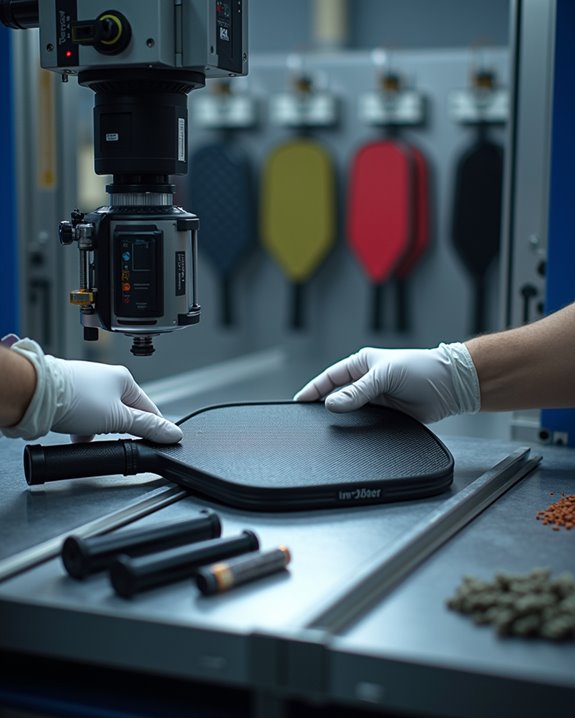
Behind every premium pickleball paddle you’ll find a rigorous quality assurance process that resembles a master chef’s obsession with perfection. Manufacturers execute at least 30 distinct quality control processes before your paddle reaches your hands—each one a careful ingredient in the recipe for excellence.
When you’re paying top dollar, you’re funding USAPA certification costs ($450 registration plus $1500 per paddle), ensuring your equipment meets strict performance and durability standards. Like a fine reduction sauce, manufacturers distill innovative materials through extensive paddle testing to create the perfect sweet spot for your game.
The production costs reflect this meticulous approach—each paddle simmered through compliance checks and manufacturing processes until it achieves the perfect balance of power and control that you’ll taste in every well-placed shot.
Frequently Asked Questions
Is It Worth It to Buy an Expensive Pickleball Paddle?
Yes, it’s worth investing if you’re serious about improving. You’ll notice performance differences and durability factors from better material quality. Consider your weight preferences, grip styles, and read user reviews before purchasing. Advanced techniques benefit from quality paddles.
How Much for a Decent Pickleball Paddle?
Like finding your athletic soulmate, a decent paddle is your gateway to enjoyment. You’ll spend $50-$150 depending on materials and performance differences. Budget options start at $25, while advanced technology commands higher prices. Consider user reviews before purchasing.
Why Are Pickleball Paddles More Expensive Than Tennis Rackets?
Your pickleball paddles cost more than tennis rackets due to advanced materials, complex manufacturing processes, specialized designs, and new technology. Production costs are higher, while market demand and brand reputation also drive prices upward.
What Brand Is Best for Pickleball Paddles?
When comparing pickleball paddle brands, there’s no single “best” choice. Your ideal paddle depends on your playing style, grip size importance, and weight preferences. Consider user reviews, material quality, and durability factors before making your decision.

